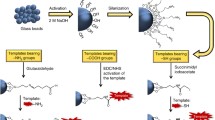Abstract
A facile, robust and cost-effective suspension polymerisation methodology for the generation of ibuprofen molecularly imprinted polymers in bead formats was evaluated. Mineral oil was employed as the continuous phase whereby microdroplets of the pre-polymerisation mixture were formed through vigorous agitation, followed by photo-polymerisation resulting in formation of imprinted beads. For comparison purposes, irregular particles were also prepared from monolith polymers. Physical characteristics of the imprinted polymers were investigated using scanning electron microscope, particle size distribution, nitrogen sorption porosimetry and solvent swelling ratios, with subsequent correlation of these parameters to analyte rebinding performance. Overall, an increase in affinity was observed with decreasing the degree of cross-linking, however, specific rebinding was compromised. An inverse relationship between polymer affinity for the template and surface area was identified, while solvent swelling ratios were directly related to polymer affinity. Correlation between pre-polymerisation studies and polymer binding performance highlighted the significance of employing the polymerisation solvent in template rebinding in order to achieve superior recognition capabilities. Additionally, shape selectivity of binding sites was demonstrated by the decreased binding performance of template structural analogues to the imprinted polymer.








Similar content being viewed by others
References
Alexander C, Andersson HS, Andersson LI, Ansell RJ, Kirsch N, Nicholls IA, O’Mahony J, Whitcombe MJ (2006) J Mol Recognit 19(2):106
Wulff G, Vesper W, Grobe-Einsler R, Sarhan A (1977) Macromol Chem Phys 178(10):2799
Arshady R, Mosbach K (1981) Macromol Chem Phys 182(2):687
Kempe H, Kempe M (2004) Macromol Rapid Commun 25(1):315
Caro E, Marcé RM, Cormack PAG, Sherrington DC, Borrull F (2005) J Sep Sci 28(16):2080
Suedee R, Srichana T, Rattananont T (2002) Drug Deliv 9(1):19
Kempe H, Kempe M (2006) Anal Chem 78(11):3659
Piletsky SA, Piletska EV, Karim K, Freebairn KW, Legge CH, Turner APF (2002) Macromolecules 35(19):7499
Mijangos I, Navarro-Villoslada F, Guerreiro A, Piletska E, Chianella I, Karim K, Turner A, Piletsky S (2006) Biosens Bioelectron 22(3):381
Brunauer S, Emmett PH, Teller E (1938) J Am Chem Soc 60(2):309
Abrahams RJ, Fisher J, Loftus P (1988) Introduction to NMR spectroscopy. Wiley, New York
Osmani Q, Hughes H, Flavin K, Hedin-Dahlstrom J, Allender C, Frisby J, McLoughlin P (2008) Anal Bioanal Chem 391(4):1229
Pérez-Moral N, Mayes AG (2002) Bioseparation 10(6):287
Sing KSW (1985) Pure Appl Chem 57(4):603
Spivak DA (2005) Adv Drug Deliv Rev 57(12):1779
Guyot A (1988) Syntheses and separations using functional polymers, 1st edn. Wiley, Chichester
Sherrington D (1998) Chem Commun 21:2275
Svec F, Fréchet JMJ (1995) Macromolecules 28:7580
Wei ST, Mizaikoff B (2007) Biosens Bioelectron 23(2):201
Urraca JL, Carbajo MC, Torralvo MJ, González-Vázquez J, Orellana G, Moreno-Bondi MC (2008) Biosens Bioelectron 24(1):155
Holland N, Duggan P, Owens E, Cummins W, Frisby J, Hughes H, McLoughlin P (2008) Anal Bioanal Chem 391(4):1245
Kempe M, Mosbach K (1991) Anal Lett 24(7):1137
Spivak D, Gilmore MA, Shea KJ (1997) J Am Chem Soc 119(19):4388
http://sparc.chem.uga.edu/sparc/ (2011). Accessed June 2011
http://www.molinspiration.com/cgi-bin/properties (2011). Accessed June 2011
Acknowledgements
This study is supported by the Irish Research Council for Science, Engineering and Technology (IRCSET) under the Embark Initiative. The authors gratefully acknowledge Dr P. Manesiotis for fruitful discussions and advice.
Author information
Authors and Affiliations
Corresponding author
Rights and permissions
About this article
Cite this article
Osmani, Q., Hughes, H. & McLoughlin, P. Probing the recognition of molecularly imprinted polymer beads. J Mater Sci 47, 2218–2227 (2012). https://doi.org/10.1007/s10853-011-6032-4
Received:
Accepted:
Published:
Issue Date:
DOI: https://doi.org/10.1007/s10853-011-6032-4




